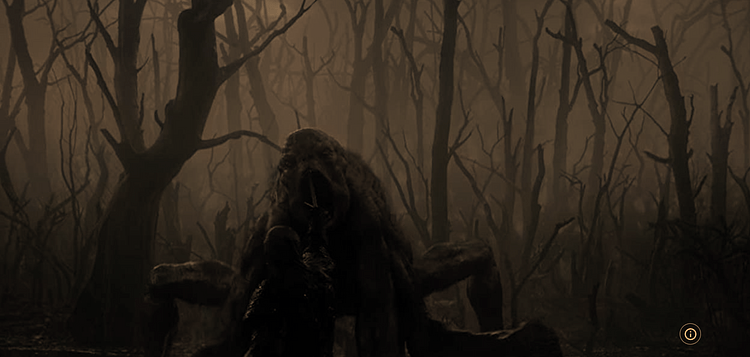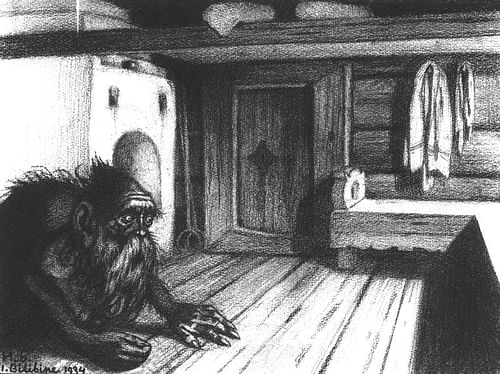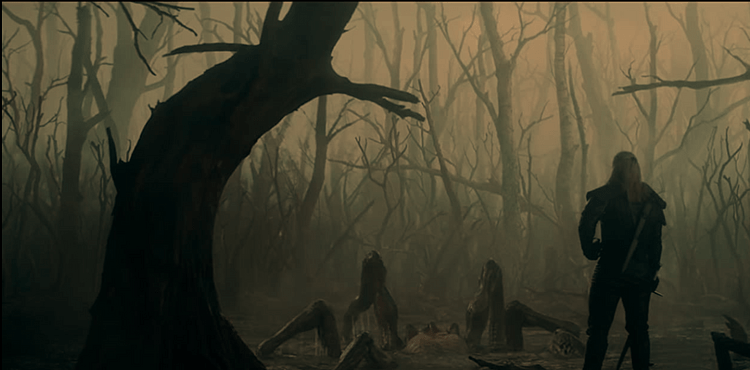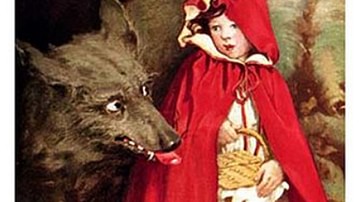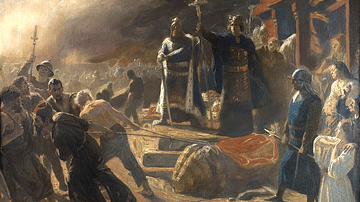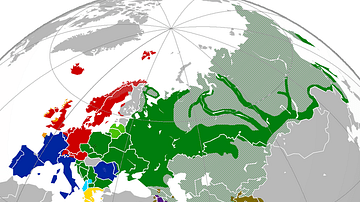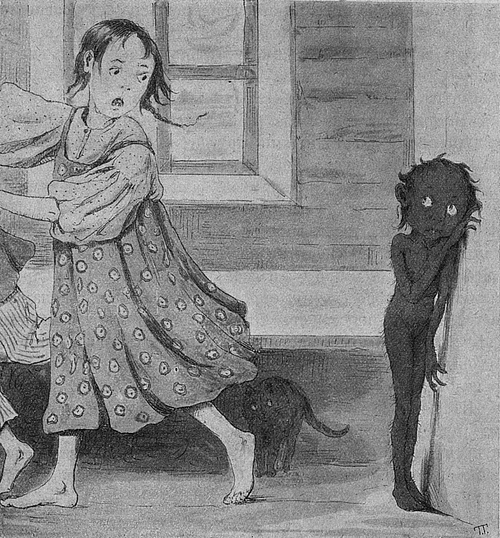
Kikimora (pronounced Kih-kee-mora) is a female house spirit from Slavic lore who can be helpful or malevolent depending on the behavior of the homeowner. In differing versions of her stories, there are two kinds of spirit, one generally helpful and the other hurtful, both depicted as a woman sometimes with a chicken’s beak or duckbill.
A kikimora might also have a dog’s snout or some other aspect of an animal’s face or body but is always feminine and might appear simply as an old woman, a beautiful girl, or a household servant. Problems in the home were attributed to these spirits who were thought to act out either because the people of the house failed to keep it in order or because they generated negative energies through their behavior. The kikimora who is married to the male household spirit known as a domovoi (also given as demovik, demovoy) is generally benevolent while the one from the swamp, sometimes associated with the entity Leshy, kidnaps children and unsuspecting adults who stray into the wild and also slips into homes through the keyhole to cause mischief; this kikimora is associated with demonic activity and specifically with the Slavic witch Baba Yaga.
A kindly kikimora who approves of how the house is kept will pitch in and help with the work, only causing trouble if people are lazy and fail to keep order. If one wishes to rid oneself of a kikimora, the surest way is to keep a home so clean she gets bored and leaves; this belief inspired women to be diligent about housework. Similarly, children were taught that the kikimora was attracted by noise at night and so they should be quiet and go to bed when told or a kikimora would take their breath, give them terrible nightmares, or take them away; this encouraged an orderly nighttime routine.
The figure developed at some point prior to the 8th-13th century when Slavic paganism was replaced by Christianity. Even after the acceptance and spread of Christianity, which devalued and dismissed many Slavic supernatural entities, the kikimora continued as a reality in Slavic households simply because the belief helped maintain order and discipline and explained the otherwise unexplainable, including night terrors, missing items, deaths of women and children, and strange noises or occurrences around the home.
The figure is best known today from the Netflix television series The Witcher, adapted from the book series of the same name, which also inspired the popular video game, though the kikimora in all of these bears no resemblance to the mythological figure. Belief in the kikimora continues in the present day through Slavic folk religion and its association with the devil and demonic forces in Slavic Christianity.
Name & Origin
The English kikimora possibly comes from the Russian kuku’mopa, a name whose meaning is debated. According to writer Ronesa Aveela, the name may have derived from the Finnish word for 'scarecrow' or the Slavic mora for the dead. Other suggestions link the etymology to words for demon, death, crookedness, nightmares, crying, or howling. The connection of the name with concepts of death, crying, and howling make the most sense as the kikimora, among its many other nocturnal activities, was believed to be the cause of sleep paralysis during which a person is awake but immobilized; the kikimora was thought to be sitting on the person’s chest during this time, preventing them from even crying out and terrorizing them with thoughts of dying.
The concept of a household spirit appears in cultures around the world from antiquity to the present. The Manes, Lares, and Penates of ancient Rome served some of the same basic purposes as Bes in ancient Egypt, the Brownie of Scotland and England, or any other "wee folk" who invisibly inhabit the home as protectors of the family and helpers as long as they and their environment are honored and treated with respect. If they are not, they cause trouble in some way related to the perceived insult and so, for example, if they are not remembered with a snack left out on the kitchen table, instead of tidying up during the night, they might hurl the ashes from the hearth around the room.
The kikimora may have originated in a legend featuring Svarog (also given as Swarog), the god of the sky, fire, the hearth, and smithing in pre-Christian Slavic religion. In this tale, Svarog creates an ideal space in the heavens for all the beautiful entities that surround him but, in time, a number of these spirits become dissatisfied with their paradise and want things their own way.
The spirits conspire to overthrow Svarog, but he is a god, after all, and knows of their plan before they can set it in motion. He catches the conspirators and hurls them out of the heavens down to earth where he decrees they will remain. They fall through the skies and into the chimneys of homes, becoming lodged in the hearth. Repenting their foolishness, they vow to look after the inhabitants of the houses by keeping the fire going, warning the family of possible dangers, and helping to maintain order and bright energies in the home.
Christianity suppressed Slavic pagan beliefs or transformed them, and many details of the old faith have been lost. There is, therefore, no definite date available for the appearance of the kikimora in Slavic culture nor for this particular tale and so the connection is entirely speculative. The household spirits in this story are not noted for acting out when they feel slighted, which is a significant characteristic of the kikimora, so there may be no connection at all. It is possible, however, that the concept of the particularly Slavic household spirit originated or was influenced by this tale as the kikimora (and domovoi) is almost always associated with the hearth and is said to live behind the stove.
Legendary Origin
Even so, in legend, their origin has nothing to do with the hearth but often involves the tragic death of an infant or young child, a woman (either before marriage, in childbirth, or old age), or a woman being seduced by a demonic entity. There is no single origin tale for them but, rather, a variety of events thought to give them life.
Stillborn children and miscarriages were thought to become a kikimora as well as a child who died before it was baptized. The soul of a woman who committed suicide was also thought likely to become a kikimora as well as those of matriarchs who were used to supervising the home and refused to leave at death. Children cursed by their parents for any reason were also considered likely candidates as the curse called the devil’s attention to the child who then began to work his influences until the soul of the child faded into a kikimora.
As the spirit was understood as female, girls were primarily at risk, but it seems young boys may have also been transformed. Young women of marriageable age were thought especially susceptible to diabolical magic in the form of handsome young men, actually demons, who seduced them with lavish gifts or, usually, left enticing items along paths the woman would walk, and if she brought one home, she gave the demon permission to enter the house. Once the demon had impregnated the woman, he left and the gifts turned to ash; her child would be born deformed with pointy ears and then become a kikimora.
A common fear had to do with the changeling – a demon child who replaced one’s actual child, usually in infancy – and this was associated with a kikimora. The spirit was thought to enter through the keyhole of a house, replace one’s child with their own, and leave quietly to raise the baby as a kikimora. Scholars Maria Leach and Jerome Fried comment on the belief in the keyhole as among the most common entry points for spirits in a house, including the kikimora:
The keyhole, in common with the door, chimney, or other openings of the house, is a place for the entrance of demons, witches, or the devil. If the key is left in the keyhole, no evil spirit can enter…Fear of the open keyhole is especially great when there is a new-born child in the house on account of the belief in changelings. (576)
Once the kikimora’s child is switched with the mortal infant, the parents raise it as their own until they notice peculiar behavior that alerts them to their child’s true identity as a kikimora. Aveela cites the example of parents deciding not to teach their child to read ahead of his age group because others in the community might consider him a kikimora.
Appearance
The kikimora is usually depicted as an old woman in faded or ragged clothing and a headscarf but she can assume many different forms. Sometimes she is a woman with a chicken beak or some other attribute of a domestic animal, other times she is a beautiful young woman; she might take on the image of a deceased family member or might appear as a hairy, goat-like entity with glowing eyes and horns. She is sometimes associated with witches, and some of the possible origins of witches were linked with the creation of a kikimora. Scholar Andreas Johns comments:
Folk belief provides many explanations for how women become witches: The seventh girl born in family becomes [a witch or] in three generations of girls born out of wedlock, the third-generation girl becomes a witch, or a dying witch transfers her power to another woman. (55)
The association of the kikimora with witches seems to have sometimes linked the spirit with the infamous witch Baba Yaga who flew through the skies in a mortar propelled by a pestle searching for children she could make into her evening meal. Just as Baba Yaga preyed on the young, so did a kikimora, and both had significant supernatural powers. This aspect of the kikimora is at odds with her role as a benign protector and helper in the home but is understood as applying most often to only one of the two kinds of the kikimora.
Kikimora, Domovoi, & Leshy
As noted, the spirit is of two distinct types: one benign and the other malevolent. The helpful kikimora will live happily with a family and assist in the ordering and cleaning of a house unless she is disrespected. This spirit is understood as married to the domovoi of the house who is also benign and supportive unless angered. Leach and Fried comment:
[The domovoi are defined as] "The one in the house": a Russian household spirit, ancestral and usually the founder of the family, who watches over and protects the inhabitants of the house, taking care that all is in order…The demovik lives behind the stove, he likes fire, and one of his punishments when the family displeases him is to burn down the house. When the family moves, brands of the old fire are carried to the new home, and the demovik is welcomed there as the new fire is lit. He is an old, grey-bearded man, looking very much like the living head of the family. His correct name is never used; he is called "he" or "himself" or "grandfather". Some the supper is left out over night for the demovik, who bustles about in the dark, always busy, guarding against the intrusion of strange and hostile spirits…There are several kinds of demoviks: the barn spirit, kitchen spirit, or bathroom spirit. Every house has them. (321)
The domovoi is understood as the embodiment of a Rod – the pre-Christian god of a family – and his purpose is to ensure that family’s well-being. When a family moves, if the domovoi is not formally invited, he remains in the old home and will fight with the domovoi of the new family, causing all kinds of trouble, until the invitation is properly offered and he moves to the new home. The kikimora associated with domovoi serves this same purpose as a protective entity, but the kikimora linked with Leshy is a completely different sort of spirit.
Leshy is a supernatural entity who reigns over the forest, protecting wildlife, plants, and trees from abuse by humans while allowing for respectful hunting and the harvesting of wood. Scholar Carol Rose describes the figure:
His name is derived from the word les, which means "forest". He is described as having the shape of a human but with strangely pallid flesh, green eyes, green beard, and long, straggly hair, wearing his boots on the wrong feet and throwing no shadow. The Leshy was a shape-shifter that could stand as tall and in the likeness of the forest trees or assume the size of a blade of grass. He knew and could make every noise of the forest, deceiving humans who strayed there. (222)
People who wandered into the woods, or those the Leshy thought were there to cause trouble, were lured deeper and deeper into the thickets and never seen again. The Leshy was married to a similar entity usually known as a Lesovikha with whom he has children known as Leshonki who will grow up to find their own forests to protect. The Lesovikha figure is sometimes associated with, or replaced by, a kikimora who lives in the swamps near forests.
This kikimora is quick-tempered and antagonistic and is drawn to homes with dark energy, such as those in which domestic abuse is a daily occurrence, entering through the keyhole. The family is first aware of her presence in the morning by her wet footprints across the floors but soon come to know her wrath regularly as she breaks items, steals objects, causes nightmares, and may even abduct children, especially those who were cursed by their parents, an act also associated with the Leshy. The abducted child would then be raised to become a kikimora.
Conclusion
The kikimora, like most supernatural entities, served to encourage the observance of cultural values. If a woman did not keep a clean house, if a husband was abusive and lazy, if children were poorly disciplined, they were thought to be sending out an invitation to a kikimora to inhabit the home. Once in the house, as noted, one could only get rid of them by reversing one’s behavior, respecting their presence, and leaving them gifts and snacks.
The spirits also explained tragic events like the death of a child, young woman, expectant mother, or matriarch who had been in good health. These events were blamed on the malevolent kikimora of the swamp who might just as easily take a child who was loved and wanted as one whose parents had cursed it. They were also believed to be the cause of mundane annoyances such as the loss of common objects. If one could not find one’s rake or hoe or lantern, it was blamed on a kikimora, and they were under no obligation to return anything.
In The Witcher books, show, and video game, the kikimora is presented as a huge spider-like monster with a thick shell. The author, Andrzej Sapkowski, drew on Slavic lore to create many of the creatures that the hero, Geralt of Rivia (the Witcher), battles but changed them significantly for dramatic purposes. In the world of the novels, shows, and game, a warrior battling a small duck-billed house spirit would seem absurd; but those who claimed to have experienced an angry kikimora would probably prefer taking on a giant spider any day.
